MODULATING JAMS OF SUMMER 2015 - PART 2
[Editor's Note: We welcome back phish.net contributor and musicologist Mike Hamad, who shares his thoughts on the "Modulating Jams of Summer 2015." Below is the second of three parts. If you missed it, you may wish to start with part one. Part three will run tomorrow. -PZ]
PART TWO
Modulation Types & Pathways
The 37 modulating jams of summer 2015 fall into five categories. I’ll discuss these in turn, along with common pathways (and exceptions) for getting from point A to point B (and sometimes, to point C). These five categories, and the number of jams they contain, are included in Table 2:
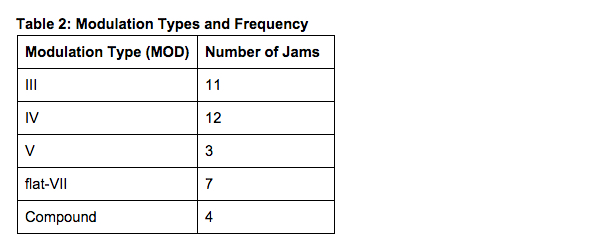
MOD III: The Light is Growing Brighter
Tonal music is based on the diatonic scale, in which two “tonics” (hence “dia-tonic”) – one major and one minor – compete for primacy. As a result, the keys built around those each tonic (B minor and D major, for example) are known as “relatives”; D is the relative major of B, and B is the relative minor of D. This extends enharmonically to any other set of relatives: A min/C maj, E min/G maj, and so on. Relatives share a key signature (two sharps, in the case of B/D) and the majority of their pitches (chromatic pitches, such as G# and A#, are brought in to tonicize B minor, but that’s not important here.)
In B minor, or any key, the chord built on the third degree of the scale (i.e. D major) is known as the mediant. MOD III jams, then, modulate from the tonic key (i.e. B) to the key located a minor third (three half-steps up on the piano keyboard) above it (i.e. D major).
MOD IIIs are close, easy modulations (there’s no change in location on the circle of fifths); the bassist simply chooses D, which already exists as part of the B minor scale, and makes it “home.” The other players simply buy-in with D major melodies and triads.
MOD III moves always progress from minor to major, and therefore they’re filled with a sense of light overcoming darkness, happiness defeating sadness, a feeling of bliss, and so on. MOD III moves, furthermore, frequently happen at a low point in the dynamic trajectory of a jam (in my schematics, I label these “DYN DIP”). The band often rests in the new key while figuring out what to do next.
"Twist" > "Light" – 7/24/15, Mountain View, CA
Table 3 shows the eleven MOD III jams Phish played this summer, including how long they spent in each key:
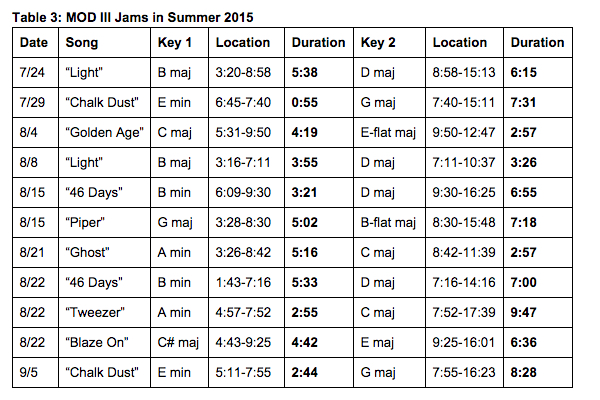
Pathways: MOD III jams that start in minor keys (“Chalk Dust,” “46 Days,” “Ghost,” “Tweezer”) simply flip over to the other tonic:
E min > G maj (“CDT”)
B min > D maj (“46 Days”)
A min > C maj (“Tweezer,” “Ghost”)
MOD III jams that begin in a major key (“Light,” “Golden Age,” “Piper,” “Blaze On”), however, require a little more work. In every case this summer, major-key jams flipped to the minor mode in the same key (what’s known as “mode-mixture”) before each move was made:
B maj > min > D maj (“Light”)
C# maj > min > E maj (“Blaze On”)
G maj > min > B-flat maj (“Piper”)
C maj > min > E-flat maj (“Golden Age”)
Why?
A minor and C major are relatives; they share tons of pitches. Moving from one to the other isn’t dramatic. A major (three sharps) and C major (no sharps), however, actually are sort of distantly removed from each other; going from one to the other, without preparation, is jarring (although the majority of Abbey Road is built on this very relationship).
Some interesting things happened in MOD III jams. The 8/4 “Golden Age” contains a transposed version of its signature bridge progression (“Love, don’t you falter,” or I-IV) into the new key (E-flat major). We heard the “Tweezer” riff in B-flat at the end of the 8/15 “Piper.” After three minutes of jamming in C major, the 8/22 “Ghost” segued into “Rock and Roll” (more on this later).
MOD IV: The High Gear of Your Soul
In any key, scale degree ^4, unlike ^3 or ^5, is a dissonance. And dissonance – in life and in music – usually leads to rapid change.
The chord built on the fourth scale degree, or IV, is often referred to as the subdominant. MOD IV jams modulate from the tonic (home) key (C major, for example) to the major chord built upon the fourth degree of the scale (five half-steps up on the piano keyboard, or F major). This represents a shift one step to the flat-side on the circle of fifths.
Like MOD IIIs, MOD IVs can either mean settling into a blissful resting place (the move from C maj > F maj in the Tahoe Tweezer comes to mind). More often, however, MOD IVs are immediate infusions of energy (as in the 8/22 “Caspian”). There’s occasionally some settling in once MOD IVs arrive, but often not much.
Table 4 lists the twelve MOD IV jams Phish played this summer, including how long they spent in each key:

Pathways: typically, MOD IVs don’t require a pathway. Mode-mixture is unnecessary. One member of the band simply bangs on the fourth scale degree. Because it’s dissonant, the others react pretty quickly. The destinations, at least in 2015, are always major keys (not minor iv).
(Quick aside: “Simple” jams usually begin with band members repeating a I-IV (F to B-flat) chord progression in F major. At 7:18 of the 8/21 “Simple” jam, they spontaneously decide to stop on the B-flat and quit alternating back to F.)
MOD V: Plugging the Distress Tube
The chord built on the fifth scale degree is known as the dominant. In tonal music, the dominant is the least stable place to be; the built-in tension resolves only with the return to the tonic (I) or a move to some other place (VI, or what’s called a deceptive cadence). In the Phish repertoire, “Steam” and “Maze” (each in G minor) are good examples of songs that have extensive jams in the dominant key (D maj/min). We all have felt how tense those jams are, for this and other reasons. When G minor returns in each case, at the end of the jams, it’s a relief.
None of that matters much here; modulations to the dominant key (seven half-steps up or five half-steps down on the piano keyboard), or MOD V, are less common than the other types, and they generally don’t feel all that tense.
Table 5 lists the three MOD V jams Phish played this summer, including how long they spent in each key:

Pathways: each of the three MOD Vs of summer 2015 preserves the mode of its starting key: 7/31 “KDF” moves from C min > G min; 8/7 “Tweezer” moves from A min > E min; 8/22 “Light” moves from B maj > F# maj. The MOD V in the 7/31 “KDF,” one of the longest jams of the summer, feels arbitrary; so does the move to F# maj midway through the Magnaball “Light” (8/22), but at least it demonstrates “Light” can do more than just MOD III.
The 8/7 “Tweezer” is notable because of what happens earlier: “Chalk Dust Torture,” a MOD IV (E min > A maj), gives us a long taste of A-ness long before “Tweezer” arrives. The MOD V “return” back to E min in “Tweezer,” then, feels like a return to the “Chalk Dust” jam. If you reduce the Blossom “CDT” -> “Tweezer” down to keys and modes, it looks like this: E min > A maj/min > E min (or I - IV - I). More than any other pairing of the summer (except, maybe, for the Magnaball “Tweezer” -> “Caspian,” discussed later), the Blossom “CDT” -> “Tweezer” acts like a unified whole.
MOD flat-VII: Now I’m on My Way
A MOD flat-VII move involves a major key jam (A major, for example) that modulates to a major key located one whole-step below (two half-steps down on the piano keyboard, or G) the tonic key.
The MOD flat-VII category has a dual nature. From a major key to another major key, MOD flat-VII represents the biggest tonal leap (two flat-side steps on the circle of fifths) of any of the MODs this summer. The three “Disease” jams (8/2, 8/5 & 9/6) that contain MOD flat-VII moves all go from A major to G major–keys that are (relatively) distant.
A minor key and a major key located a whole step apart, however, such as G minor and F major (7/31 “Twist”), or E minor and D major (8/1 “Carini”), fit right into a diatonic key (I-ii-iii-IV-V-vi-viio-I), as ii-I or vi-V, without much effort. These are tonal slots we’re used to hearing.
"Down with Disease" – 9/6/15, Commerce City, CO
Table 6 lists the seven MOD flat-VII jams Phish played this summer, including how much time they spent in each key:
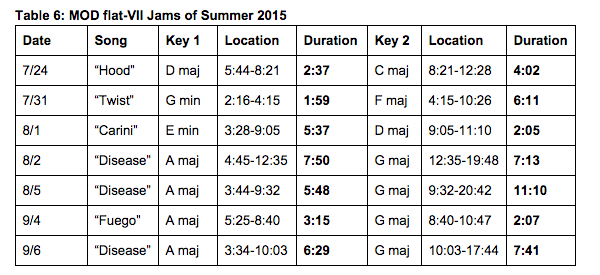
Pathways: Two possible pathways to get to MOD flat-VII include two quick MOD IVs (i.e. D > C > G in the 7/24 “Hood”); a short MOD III > MOD V (G > B-flat > F in the 7/31 “Twist”); or some other, more obscure pathway. Sometimes it’s just about opening up new tonal spaces that aren’t MOD IIIs (via mode-mixture) or MOD IV (though they do that in the 8/23 “Disease”; see above).
MOD flat-VII was the most popular modulation for “Disease” jams this summer (three of them). The 7/24 “Hood” jam, as I mentioned earlier, is an anomaly: a Type I jam song with a four-minute excursion into a (relatively) foreign key (C maj). It’s probably the most harmonically adventurous 3.0 “Hood” since 7/1/14, which spent a significant amount of time in G maj/min (MOD IV). MOD flat-VIIs in two jams on this list, the 8/1 “Carini” and 9/4 “Fuego,” barely cracked the two-minute mark, and are therefore just slightly more than last-minute swerves to segue into other songs, which might explain why a more distant modulation was chosen.
[The third and final part of this series will run here in the phish.net blog tomorrow...]
MODULATING JAMS OF SUMMER 2015 - PART 1
[Editor's Note: We welcome back phish.net contributor and musicologist Mike Hamad, who shares his thoughts on the "Modulating Jams of Summer 2015." Below is the introduction and part one, of three parts. Parts two and three will run here early next week. -PZ]
Not counting the Magnaball Drive-In Jam, Phish played 513 songs - roughly three days of non-stop music - during the summer 2015 tour, spread across 51 sets and 25 shows in 16 different venues. That's a lot of music.
A minor subset - 37 songs, clocking in at nearly ten hours - stands out not because of how good it was, but because of what happened during those ten hours: in every case, the band, as a unit, changed keys. In musical/analytical circles, this is known as "modulation."
Each modulation lasted more than two minutes. It's an arbitrary amount of time that I chose to distinguish between structural modulations, or key changes, that I felt would unmistakably weaken the music if they weren't there, and last-minute swerves, to enter new keys and set up subsequent segues to other songs. Anyway, two minutes is a good, round number.
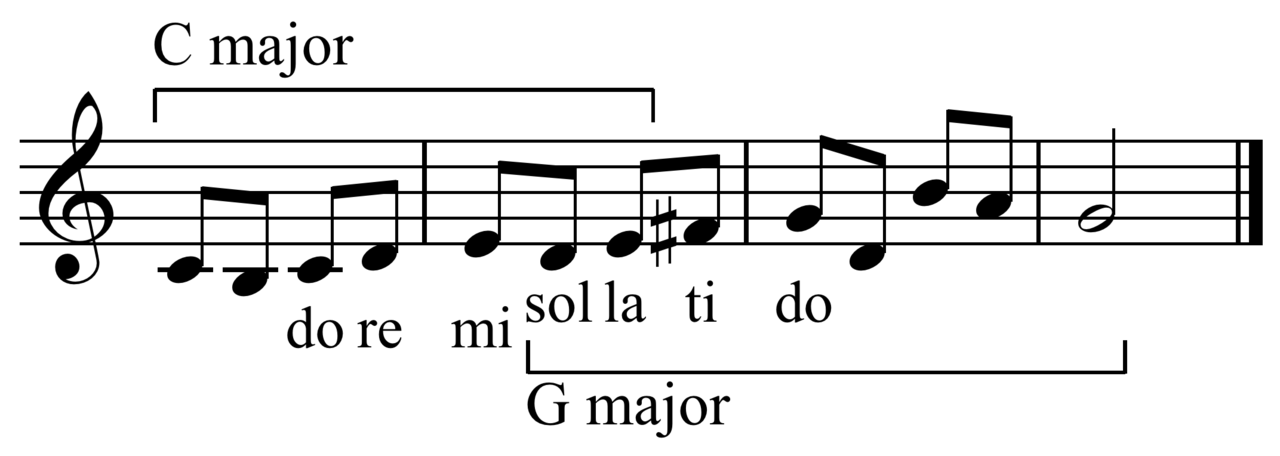
Technically speaking, this group of 37 jams represents the most harmonically adventurous collection of improvisational rock music played by Phish during the summer - the Type II-est of the Type IIs. In this series I'll discuss the different types of modulation practiced by Phish, the common pathways they use to get where they're going, and where they ended up on the other side.
In part one, I'll talk about modulation in a general sense, before getting into the group of 37 jams that meets these conditions. In part two, I'll lay out the four different types of modulation heard in the summer of 2015, as well as common pathways heard in each category. Finally, in part three, I'll discuss compound modulations, jams that nearly made the cut, and how Phish treats segues after modulating jams.
PART ONE
What is modulation?
Inclusion on this list has nothing to do with taste (or even "Taste"). Each song/jam meets a single condition: it modulates to a new key for longer than two minutes. Improvisational rock music has many things going for it, and modulation is only one. Obviously it's possible to enjoy Phish jams without hearing any of these, and that's because, at its most elemental, Phish music is dance music.
I've written about Phish and modulation for phish.net, and also for Lawn Memo's The Daily Ghost. Improvising rock musicians - arguably all musicians - think in terms of keys (F, G, A, D, etc.) and modes (major, minor, Dorian, Mixolydian, Lydian, Phrygian, pentatonic, and so on). Part of that is physical, and has to do with hand placement on an instrument. Piano players can attest that playing in B minor, for example, feels very different than playing in A minor; the same goes for the guitar and bass. (You may recall Trey's comment to Phish.net member Andrew Hitz, when they discussed the Mike's Song second jam in Nashville: "Ooh, I like jamming in F.")
Modulation isn't required for a jam to be considered "good" (check out the list of honorable mentions later in this article). But looking across Phish's enormous output over the years, there's an argument to be made that a significant percentage of Hall of Fame jams modulate at some point. (A quick scan of Matt Burnham's HOF poll tells me that six of the seven Tier 1 jams modulate.)
In a general sense, every Phish jam starts out the same way: in a certain key (A, for example, if you're talking about "Ghost") and mode (minor; more specifically, the Dorian mode, which employs the raised ^6 scale degree and the flatted ^7 scale degree). Countless "Ghost" jams (7/21/15, for example) begin and end in the same key and mode, without straying, and they're awesome.
After a while, particularly during longer jams, ears and fingers get tired of being in (and hearing) the same key and mode. Phish often switches modes from major to minor (what's known as "mode-mixture") for variety, while remaining in the same key. Mode-mixture is fairly easy, and Trey or Page, because they play chordal instruments, are responsible for this slice of the pie.
Modulation occurs when Mike decides he's going to make a new tonal center the "tonic," or "home." The lowest voice in any musical texture has this power. It's some sort of physical thing, but it's true. The other guys can (and very often do) signal that they want to go someplace else, but Mike has to buy in.
Still, I'd argue that modulation is an important part of what makes great Phish jams great. You'll find many of the most talked-about jams of summer 2015 on this list: Atlanta "Kill Devil Falls"; Blossom "Chalk Dust Torture" -> "Tweezer"; Mann "Twist"; MPP "Twist"; Magnaball "Bathtub Gin," "Tweezer" -> "Prince Caspian," and "Blaze On"; Dick's "CDT" and "Down with Disease," and so on.
Other beloved 2015 jams are not on the list: Bend "Simple"; Nashville "Stash" and "Mike's Groove"; Mann "Cities" & "Scents and Subtle Sounds"; MPP "David Bowie," and so on. I'll discuss some of these later.
Table 1 lists the modulating jams of summer 2015:
| Date | Location | Songs |
|---|---|---|
| 7/24 | Shoreline, CA | "Twist," "Light," "Harry Hood" |
| 7/28 | Austin, TX | "Ghost" |
| 7/29 | Grand Prairie, TX | "Chalk Dust Torture" |
| 7/31 | Atlanta, GA | "Ghost," "Kill Devil Falls," "Twist" |
| 8/1 | Atlanta, GA | "Tweezer," "Carini" |
| 8/2 | Tuscaloosa, AL | "Down with Disease" |
| 8/4 | Nashville, TN | "Golden Age" |
| 8/5 | Kansas City, MO | "Down with Disease" |
| 8/7 | Cuyahoga Falls, OH | "Chalk Dust Torture," "Tweezer" |
| 8/8 | East Troy, WI | "Down with Disease," "Light" |
| 8/9 | East Troy, WI | "Tweezer" |
| 8/12 | Philadelphia, PA | "Twist" |
| 8/15 | Columbia, MD | "46 Days," "Piper" |
| 8/16 | Columbia, MD | "Twist" |
| 8/21 | Watkins Glen, NY | "Simple," "Bathtub Gin," "Chalk Dust Torture," "Ghost" |
| 8/22 | Watkins Glen, NY | "46 Days," "Tweezer," "Prince Caspian," "Blaze On," "Light" |
| 8/23 | Watkins Glen, NY | "Down with Disease" |
| 9/4 | Commerce City, CO | "Golden Age," "Fuego" |
| 9/5 | Commerce City, CO | "Chalk Dust Torture" |
| 9/6 | Commerce City, CO | "Down with Disease," "Carini" |
Why these particular songs?
In this group of 37, you'll notice that there are only seventeen different song titles. Alphabetically, these are: "46 Days" (2 examples), "Bathtub Gin" (1), "Blaze On" (1), "Carini" (2), "Chalk Dust Torture" (4), "Down with Disease" (5), "Fuego" (1), "Ghost" (3), "Golden Age" (2), "Harry Hood" (1), "Kill Devil Falls" (1), "Light" (3), "Piper" (1), "Prince Caspian" (1), "Simple" (1), "Tweezer" (4) and "Twist" (4).
The most exploratory song of summer 2015, if you wish to count them, was "Disease" (five modulating jams), followed by "Chalk Dust," "Tweezer" and "Twist" (four each); "Light" and "Ghost" (three each); and "Carini" and "Golden Age" (two each).
This group of seventeen contains several different types of songs. Some are open-ended, meaning we don't expect them to return to any sort of "head," and are therefore natural choices for exploratory, Type II jams. Among this group: "46 Days" (it's usually the second jam, though 8/22 only has one jam), "Carini," "Down with Disease," "Ghost," "Golden Age," "Light," "Piper," "Simple," "Tweezer" and "Twist." Some of these had typical returns in earlier days, and some still do return to the head; see the 7/25 "Disease", for example.
Building on what they've done with "Chalk Dust Torture" in 3.0, its appearance on this list is no surprise. Prior to 2015, however, Type II "Chalk Dust" jams (7/13/14 or 8/3/14, for example) took off in the middle of the song, without the final chorus, and are therefore labeled "unfinished" by the phish.net setlist gurus. That changed in 2015; every "Chalk Dust" played during the summer was of the finished short: after a short guitar solo, Trey signaled the return of the chorus. Modulatory "CDT" jams, a la 8/31/12, are what you'd call "second jams."
"Bathtub Gin" typically returns to its C-major head before ending (8/21 is no exception), but I'm also not surprised that at least one version got spun out in 2015 (oh, and WHAT a spinning out that was). "Fuego" sometimes ends formally (see: 7/25), but it also occasionally spins out without modulating (8/11) or spins out with modulation (9/4, and many examples in 2014).
"Blaze On," a new song in 2015, always concludes before it either spins out (as on 8/22) or does not (7/28 and several others). Two additional songs - 7/31 "Kill Devil Falls" and 8/22 "Prince Caspian" - normally conclude and don't get that spun out - but these two certainly did.
"Harry Hood" is another story. In 3.0, it's unusual to hear a "Hood" jam that modulates, but it happened on 7/24, when we heard four minutes (!) of a modulation from D major to C major (flat-VII, from 8:26-12:28).
"Hood" is part of a group of songs typically known in 3.0, with important exceptions, as Type I jam vehicles, along with "Antelope," "Bowie," "Stash," "Mike's Song," "Reba," "Runaway Jim," "Split Open and Melt," "Wolfman's," "YEM," and a few others. These are some of the most welcome jam songs in the 3.0 repertoire, and they seldom modulate (although a frequent, welcome occurrence in this group is the appearance of a lengthy tonicization of another key).
Tonicization vs. Modulation
Tonicization occurs when a key area outside the tonic (i.e. the "home" key) is temporarily treated as the tonic. This new area feels like home for a little while, but not for long. Modulation, on the other hand, is deeper and more structural. (Note: all timings are from LivePhish.)
The 7/28 "Antelope," for example, is a jam that takes place in E minor, with a short tonicization of G major (III) from 4:11-4:42. For roughly 30 seconds, we feel like G major is home, before the bass slips back to E. It's a good jam, but it doesn't make this list because it doesn't technically modulate. The 8/22 "Antelope" tonicizes B major (V) from 4:52-5:39, then G major (III) from 5:40-6:18, for 1.5 total minutes of being displaced from E minor.
Similarly, in the 8/4 "Stash" jam, we hear fifteen seconds of a move from D minor to F major (III, from 6:20-6:34), then fifteen more seconds of an A major (V) tonic (from 6:35-6:50) before Mike re-settles in D minor. The 8/9 "Melt" jam (in C# minor) contains a lot of dissonance and harmonic ambiguity, but it briefly tonicizes B (7:35) and A (8:18). The 8/11 "Bowie" jam (in E minor) tonicizes G major (III) twice (at 5:27 and 6:55), and the 8/16 "Bowie" jam contains extensive tonicizations of A major (IV) at 8:09 and 9:17.
Tonicization frequently happens in jams that also modulate. The 8/1 "Tweezer," for example, a jam in A minor, contains a brief tonicization of D major (IV) from 8:25-8:46, before the eventual, seismic modulation to C major (III) at 9:51.
Location, location, location...
Not surprisingly, in 2015, the overwhelming majority of modulating jams occurred during second sets, either…
- in the opening slot (7/29, 8/7 & 8/21 "Chalk Dust"; 7/31 "Kill Devil Falls"; 8/1 "Tweezer"; 8/2 & 8/8 "Disease"; 8/4 "Golden Age")
- somewhere later in the second set (7/24, 7/31, 8/12 & 8/16 "Twist"; 7/24 & 8/8 "Light"; 7/24 "Hood"; 7/28 & 8/21 "Ghost"; 8/1 & 9/6 "Carini"; 8/5, 8/23 & 9/6 "Disease"; 8/7, 8/9 & 8/22 "Tweezer"; 8/15 & 8/22 "46 Days"; 8/15 "Piper"; 8/22 "Caspian"; 9/4 "Golden Age"; 9/4 "Fuego"; 9/5 "Chalk Dust")
- or in the one third set of the summer (8/22 "Blaze On" & "Light").
We've come to expect harmonic exploration in second sets, in other words, because that's when usually happens.
Three exceptions: the first-set Ghost on "7/31," which returned back to its home key (A minor) after a five-minute jam in D major (IV). And Magnaballers were treated to rare, modulating first-set bookends - the "Simple" opener and "Bathtub Gin" set closer - a phenomenon that recalls the latter years of 1.0.
[Look for parts two and three here at the phish.net blog next week...]
THE ASHAKIRAN TAPE - A NOVEL
Jürgen Fauth’s The Ashakiran Tape is a novel set at Jones Beach in 2009, and the following excerpt opens during the second show of the run, 6/4. After he’s had to deal with hapless noobs, sketchy scenesters, and a yacht full of strung-out tech millionaires, hardboiled lot detective Quentin Pfeiffer is finally trying to enjoy his first shows since Coventry – but the dark events of the previous days are threatening to overshadow the music.
EXCERPT (from Chapter 14)
Of course they played "Drowned."
In The Who’s Quadrophenia, the song marks a desperate moment for mod hero Jimmy — but according to Pete Townshend, it was originally intended as a love song: "I wanna drown in cold water" wasn’t a death wish but an expression of ecstatic abandon. Out of the structured section, an urgent jam exploded, teeter-tottering between stadium rock grandeur and darker undercurrents that lashed the audience like an elemental force, like the rain that came pouring down for most of the show. For a second, Quentin thought he heard the band tease "Jumpin’ Jack Flash" — it’s a gas, gas, gas! — but it dissolved before he could tune into the significance of it.
Walt and Q watched the show together from the taper's section, where it was considered good form to keep the chatter to a minimum as to not ruin the recordings. Q danced carefully, forever worried he’d bump into a 12 foot mic stand or step on someone's MacBook Pro, the situation complicated by the tarps people were using to protect their equipment from the weather.
Phish seemed much more in sync now, but the vibe was ominous. Q figured the band would have to know about the dead body fished out of the bay a stone's throw from the stage, and death hovered over the music all night long — from "Grind," a cheerful a cappella number that changed lyrics every time to count out the actual days the band members had been alive, to "Squirming Coil," "Dirt," and "Ghost." The joyfully silly dance tune "Meatstick" couldn't seem to find its bearings and was played in a wrong key and "You Enjoy Myself" was lacking its usual, blissful nirvana section. Mike Gordon was wearing purple pants, which was neither here nor there — his sartorial choices often left fans befuddled.
The show concluded with another cover, the Velvet Underground's anthem "Rock and Roll," which seemed like an attempt to find salvation in the music: "Her life was saved by rock 'n' roll," the song went, and the crowd dutifully roared at the mention of "a New York station." All Q could think about was the Skipper's horrible swollen face, lying down by the bathrooms, and the cold stare Chuck had given them, but finally the images resolved into the rousing final chorus.
"They'll need some time," Walt said as he packed up his gear after the show, "but they'll get back to where they were, and more. I'm sure of it."
"Searching for a way forward," Q said. "They seem horrified by the idea of repeating themselves, trying to relive past glories and failing. I think that's why Trey ripcords jams. Either it's fresh or he cuts it short."
Some dude wearing Mr. T levels of Mardi Gras beads around his neck had overheard them and sneered. He sang a line from "Time Turns Elastic:" "I'm a submarine, a submarine, sinking beneath the ground," and broke out into drunk giggles.
Walt invited Q over to his hotel for a beer while he tracked the show and got it ready for seeding, but Q declined — he had to get back home.
"How's the little one?"
"She's awesome. It's hard, but I wouldn't miss it for the world."
"Spoken like a real daddy."
"It's a cliché because it's true, man."
Walt nodded. Q didn't know what his story was with kids, and he'd never asked. He’d known some of Walt’s girlfriends over the years, yoga instructors and nutritionists, Waldorf teachers, all of them quite fetching, and some of them had kids now with other men. Their friendship covered more than just the music or the scene, and Q could have easily asked — but he never had, and now it seemed too late, somehow.
"Speaking of which, I gotta check in with Em — "
Walt nodded and bought two beers from a vendor while Q dug out his cell. The battery was on its last legs, but it'd do for one more call. Em picked up on the second ring.
"Quentin Pfeiffer," she said, and the way she used his full name told him everything he needed to know.
"Two house guests are quite enough for me, thank you very much. I’m not running a home for hippie chicks in distress."
"It's only for tonight, I promise. I gotta go, my battery's dying. I’ll head back now, okay?"
After he hung up, Q found himself lingering on Shakedown rather than heading straight for the car. He meandered aimlessly down the main drag and the surrounding lanes, which slowly emptied out of cars — but enough people were still hanging around, drinking beers, enjoying their highs. The mood wasn't euphoric, exactly, but the faces Q saw seemed to know they'd seen a better-than-average show with some profound moments that managed to speak, however imperfectly, to the vibe of the place and time, that addressed the mysteries surrounding the day, the death on the beach, this peculiar moment in Phish history that was, like any other day, cyclic yet utterly unique, never to be repeated in its singular configuration of hopes and dreams, disappointments and possibilities.
Unwilling to let the night end quite yet, searching for something he couldn’t put his finger on, Quentin turned and ambled down Shakedown one more time. From way beyond the far end came the telltale hiss of a tank — someone was selling nitrous. Hippie crack, they called it. The high didn't last, it was terrible for your brain, and a fucking balloon of the stuff was up to what now, $8? The margins were astronomical, and the people selling it were famously profit-driven and somewhat less than invested in the health of the scene. Q hated the stuff, but already clusters of people with moronic grins, some of them holding two or three balloons each, were stumbling his way or slumped out on the ground, like a kid's birthday party gone stupendously wrong.
He found a curb at the edge of the lot to sit down for a moment, closed his eyes, and breathed in the cool air. He attempted to read the moment, feel his way through the remaining crowd to get a sense of the secrets still hiding out, but he couldn't find the right place to do it from — couldn't get time to slow down and stretch, couldn't get a handle on the night.
His phone beeped, not with a message notification but a battery warning: it would be out of power shortly. He flipped it open and dimmed the display to squeeze a few extra minutes out of it and noticed that he did have an unread message after all: a text from Dana.
Q had tried to call her before the show to see if she'd gotten the news and if she was okay, but when she didn't pick up, he’d only left brief voice mail.
Her text read: "Need to talk to you. At the marina. URGENT."
He tried calling, but his phone went dark on the second ring. Quentin Pfeiffer stood by the edge of the emptying parking lot and cursed.
###
The Ashakiran Tape (HEAD CASES Vol. 1)
From the author of the historical thriller Kino, a "fast, complex, exhilarating roadster ride through history and time" (Frederick Barthelme) comes a gripping psychedelic mystery steeped in sex, drugs, and rock ’n' roll.
When legendary improvisational rock band Phish returns to the stage after a five-year breakup, longtime fan and hardboiled hippie sleuth Quentin Pfeiffer has to be there — even though he is older, wiser, and the father of an adorable baby daughter now.
But not everything is sunshine and rainbows in the freewheeling circus surrounding the band's summer tour: after the millionaire skipper of a drug-drenched luxury yacht goes missing, Q and his crew are drawn into a dangerous intrigue of dreadlocked dames, shady tape collectors, and spun-out wookies chasing after the long-lost recording of a mysterious late-night jam.
Inspired by Raymond Chandler and set during a series of concerts at Long Island's Jones Beach amphitheater, The Ashakiran Tape takes readers deep into the spiraling ecstasy of Phish's epic shows and the seductive underworld of the obsessive fans following them.
BIO
Jürgen Fauth’s first Phish show was 4/26/96, New Orleans Jazzfest. He is the author of the novel Kino (Atticus Books, 2012) and Raves (2014), a collection of movie reviews. He has been called “for better or worse, the only person to ever provoke Robert Hunter to write a semiformal explanation of one of his songs” (Jesse Jarnow). Jürgen holds a Ph.D. in Creative Writing and divides his time between Berlin, Germany, and Dakar, Senegal. You can find him online at jurgenfauth.com, and on Twitter at @muckster.
MORE: http://jurgenfauth.com/the-ashakiran-tape/
AMAZON: http://www.amazon.com/dp/B015EINWXE/
PHISH HIT THE ROAD & PLAYED A TOUR THIS SUMMER - YOU WON'T BELIEVE WHAT HAPPENED NEXT!
Unexpected things are part and parcel of the Phish experience and have always added to the mystique, aura, and wonderment of this band. Tours are usually sprinkled with a few surprise moments but this summer seemed to be chock-full of surprises.
What surprised you the most?
Read on to learn about the ten most surprising things that the band did this summer.

10. Sold Out Magnaball. And Dick’s. If you told most fans after the New Year’s run that they better not sleep on Magna and Dick’s tickets this year, they probably would’ve looked at you like you were mad. While the “Fare Thee Well effect” likely made a small difference, it was really a “Phish” effect. With incredibly strong playing and a stellar Summer Tour, it is no wonder that many who were on the fence decided to pony-up and get their asses to these shows. Admittedly, despite the admonition not to arrive without tickets in Watkins Glen, tickets were ultimately sold at the gates. (Presumably only to fans arriving in a car with other ticketed fans but with a little bullshitting, anyone got in.) Nevertheless, it was surprisingly strong demand for both.

9. Debuted Heavy Rotation Page’s “Heavy Rotation” was released on his self-titled album all the way back in 2007. And indeed, Sirius’ “JamOn” channel really did put it into a heavy rotation after the album was released. Yet, several months later the song disappeared from Sirius, and after it being played at every single show of Page’s tour in 2007, it was but a distant memory. That is until the first set of the second Bend show. It fit in nicely with a band member “side-show centric” set. (2-26-2003 in Worcester had a very similar setlist construction). The Bend show also included Trey’s “Scabbard” (also a Phish debut) and “Winterqueen” and Mike’s “How Many People are You” (yet another Phish debut). While it is always possible for Phish to cover a song performed by a band member, given the eight years since “Heavy Rotation” was performed, that was most surprising.

8. The Landlady Landlady has been around since the beginning of time - specifically 1989 when the “Latin-esque” instrumental ditty was sandwiched between “Punch You In The Eye”. After “Punch” was shelved, the standalone “Landlady” portion reappeared on 9-13-1990 and was played seemingly every night for a couple years. It was so common, that I’ve personally seen it 73 times. Yet, the “Landlady” was evicted in 1994. While of course, the “Punch You In The Eye” returned after a 414 show gap on 2-5-1993 at the Roseland and continued with relatively common frequency. So while many fans had a standalone “Landlady” on a personal bucket-list despite all the “Punch” performances, it wasn’t until the last night of Dick’s that they were able to check it off the list. A 768 show gap. Nearly twice as long as the Punch gap.
[Landlady. 9-6-2015 at Dick's. Video by @kembra allen]
7. First Sets that mattered. Look, this isn’t overly harsh or critical, but let us be honest with ourselves. Most first sets since the triumphant return in 2009 have lacked significant replay value. Don’t get me wrong: They don’t all suck and many (most?) are a total howl to be at in person. But candidates for entry in the revered “Jam Charts” and sets that really kicked ass? There are scant few in the last seven years. 2015 included many “first sets that mattered”. Among many 1st set gems included “Reba” from Shoreline, “Bathtub Gin” from Watkins Glen and “David Bowie” from the Mann. It was great that so many shows got the memo, particularly Magnaball Night 1 and Alpine Night 2. (Sadly, the memo didn’t circulate to Dick’s 3.)
6. No F’s. No Fluffhead. No Fee. No Foam. This is a particular tragedy to me as these three songs number among my “Top 10” favorite Phish tunes. The expectation of a monumental “Fluff” on the final night of Dick’s was palpable. The odds were so favorable, Vegas likely wouldn’t even take the bet. When “Fluffhead” opened 3.0, it was the longest show gap that it had ever had as it had not been performed since 2000. Yet, throughout 3.0, it has been a stalwart appearing in every year and every ten shows or so. No “Fluffs” this summer at all. Likewise, “Fee”, while not as common as “Fluff”, was a notable omission from 2015 Summer setlists. “Foam” also fell into a deep well, never to surface.

[This didn't happen here or anywhere else.]
5. No F's? No D's either. D for Dead. Many fans were convinced Trey was going to put to use his many hours in the woodshed preparing for “Fare The Well” and bust out a Grateful Dead song or two over the summer. There’s no doubt he approached some songs differently and perhaps teased a song or two. Fans variously heard “Dark Star” all over the place, “Terrapin Station”, “I Know You Rider”, and “Scarlet Begonias” teases and perhaps others. But after the final notes of “United We Stand” were played: Final Grateful Dead song count tally: 0, null set, zero, zilch, zip.

4. Debuts That Crush Hell yeah, in the history of Phish, tons of songs come out of the gate and just kick ass and take names from Day 1. But that’s kind of ancient history. Many 3.0 debuts have ripened on the vine and matured like a fine wine over time. In the Summer of 2015, no fewer than three songs came out of the gate running: “Blaze On”, “No Men In No Man’s Land” and “Mercury”. If you need evidence of how finely tuned these songs are, check out the very second “Blaze On” from Shoreline or the Magnaball version from Watkins Glen. Likewise, “No Men” had many strong performances: pretty much take your pick of any of nine. But personally, I really enjoyed The Mann and Magnaball performances. Finally, you only have a pick of three Mercuries. But good Lord: what a trifecta!
["Mercury" at Alpine on 8/8/2015. Video by @madpicken]
3. Five or Six Song Set Five song sets are common. You know, if we are talking 1997. But 2015? Yeah. It happened. 8-12-2015 was a throwback to an era where five (or even four!) songs could command an entire set in spectacular fashion. “Bathtub Gin”, “No Men In No Man's Land” > “Twist”, “Scents and Subtle Sounds” and “Harry Hood” was the set. Read that again. That was the entire set. “No Men”, “Twist” and “Scent” all were epic enough to earn spots on the Jam Charts. Previously in the tour on 7-24-2015, another spectacular set only included six songs: “Blaze On” > “Twist” > “Light” > “Joy”, “Harry Hood” > “Cavern”. All but “Joy” and “Cavern” have spots etched on the Jam Charts.
2. Return of "Second Jam" in Mike’s. Much ink has been spilled all over, both on the web, and here on Phish.net about the triumphant return of the “Second Jam in Mike’s”. For fans lucky enough to be at Ascend Amphitheater in Nashville, they witnessed this highly anticipated jam for the first time since 7-14-2000. Had it just been the “Mike’s”, fans would have left happy but it additionally contained a great “Piper” and culminating in the ferocious “Crosseyed-Groove”.
"Mike's Song", 8-4-15, Nashville, TN. Video by @LazyLightning55a
1. Dick’s Encore - THANK YOU Who possibly could have predicted one of the most, if not THE MOST STUNNING encore in the history of the band? After a great three nights to close the Dick’s run and the special 2015 Summer Tour, the bombastic notes of “Tweezer Reprise” engulfed the stadium and signaled the end of the run. Umm….wait, not so much. Spelling out ‘THANK YOU’ and continuing the tradition of “setlist antics”, the encore continued with “Harpua” > “After Midnight” > “NO2” > “Keyboard Army” > “Your Pet Cat” > “Once in a Lifetime” > “United We Stand”. In all that craziness we only had:
1) Perhaps the most entertaining “Harpua” ever performed
2) The first ”Keyboard Army” since 1995
3) The first “Once In a Lifetime" since its debut it 1996
4) An entertaining “NO2”
and
5) The debut of “United We Stand”.
So yeah, that. I knew it was coming all along.
"THANK YOU" encore at Dick's.
Honorable Mention:
> Halloween Songs That Really Stuck Around Fuses, Cats, Dogs, Birds, and particulary Monsters were scattered liberally throughout the summer. "Martian Monster" was showcased variously as a show opener, set opener, set closer, Free Interlude and Little Feat mash-up. Mike previously stated in an interview that many of these were written as deep grooves to have open space to build on, and "Martian Monster" is indeed deep, and as successfully versatile as anything in recent memory. Perhaps no surprise as “The Haunted House” set was one of the most well received sets in Phish’s long history.
> No Randall’s After an overwhelming successful three-night stand in the Summer of 2014, I think many people assumed an encore performance was in store. With an almost festival-like vibe, ample space, fantastic acoustics and prime geography in one of the most densely fan-populated areas of the country, hopefully 2016 is on the horizon.
> Loose and liberal segues and sandwiches While this IS what Phish does and really should NOT be a surprise- the success and the way segues flowed especially as tour went on was jaw dropping. It represented a huge step above anything else in 3.0. "Martian Monster" sandwiches and Steam/WTU/Steam are cases in point. Chalkdust Torture -> Twist from Dick's was one of the best pure segues in many years as was the "Chalkdust -> Tweezer" (Or "Cheezer") from Blossom.
> No Northeast Shows Why does the Northeast always get shafted? Enough said. Hopefully this diabolical pattern ceases next year. Interesting reading here about tour patterns.
> Mexico Announced Though there were ample rumors, it was easy to write them off as yet another of the millions of rumors that don’t pan out. Even when URLs and images started circulating, many still thought it was an elaborate prank. But it was true. Phish is playing somewhere other than the United States or Canada for the first time since Osaka, Japan on 6-16-2000.
What did I miss? What were YOUR most surprising things from Summer 2015?
DICK'S XV: YOU'RE WELCOME
Heading into last night's summer finale at Dick's, it's safe to say there was a sense of collective unease. The first two shows of the run were solid, but decidedly unspectacular. Phish is currently playing at a high level, so by no means were Friday and Saturday nights bad shows. They just felt a little... ordinary. The Friday spelling tradition was seemingly put to rest and there was little acknowledgment that we were at DICK'S. It was understandable. Magnaball was such a smashing success, that it was going to be nearly impossible for this run not to feel a little anti-climactic.
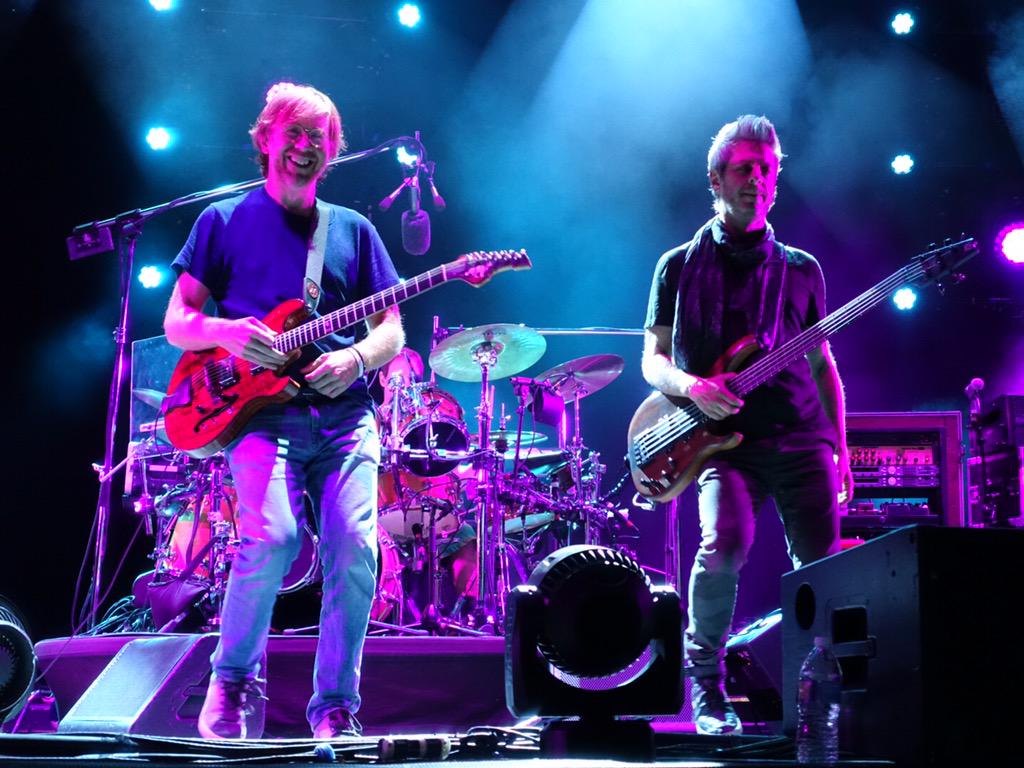
"The Landlady" – Photo © @tweeprise
Phish came out and played two sets that largely stuck to that script. It was going to be my job to shine a light on the high points, note some of the more questionable calls, and try not to let too much of my disappointment show through that this year's Dick's shows felt like just another three-night run. And there were some genuine high points, most obviously the sterling "Down with Disease."
Alas, in the first set, those high points were not always easy to come by. A languid "Landlady" opener crossed off a never-before-seen song on many fans' lists (though they had, of course, likely seen it many times inside of "PYITE"). The "Free," "Moma," "Seven Below" sequence that followed showcased a veritable murderer's row of anthemic Trey licks. It's more difficult to be charitable about the song selection from the rest of the first set. But why on earth should we dwell on that here? And, hey, that's just, like, my opinion, anyway. I'm sure there are some folks out there who thought each call from "Caspian" through "Halfway to the Moon" was better than the last.

"Frankenstein" – Photo © @tweeprise
Setbreak was longer than usual, and the clock watchers among us noted ominously that Phish had only given themselves about an hour and twenty minutes for the second set and encore. That wasn't necessarily ideal, but sometimes shorter sets tend to be more focused, delivering wall-to-wall meat. That wasn't necessarily the case last night. The aforementioned "Disease" certainly fit the bill, as they deconstructed the jam to a minimalist groove and then built it back up into major-key euphoria. The last minute of the "DWD" seemed to hint at "Tweezer" before downshifting into "Carini." At just nine minutes, the "Carini" is compact but featured an echoplex-fueled jam that was reminiscent of 12/29/13.
"Compact" would be the watchword of the set, as "Steam," "Piper," "2001," and "Tweezer" all fit that description. "Piper," in particular, squeezed a lot of action into its eight-and-a-half minutes. This was all high-quality, enjoyable Phish, and had it taken place mid-tour, I'm sure I'd be singing its praises. But when "Tweezer" gave way to "The Horse," it felt like we were going to leave Dick's without a true standout show. Oddly, they started up "Slave" at 11:48. ::Does math:: How on earth are they going to play "Slave" and fit in an encore by curfew?
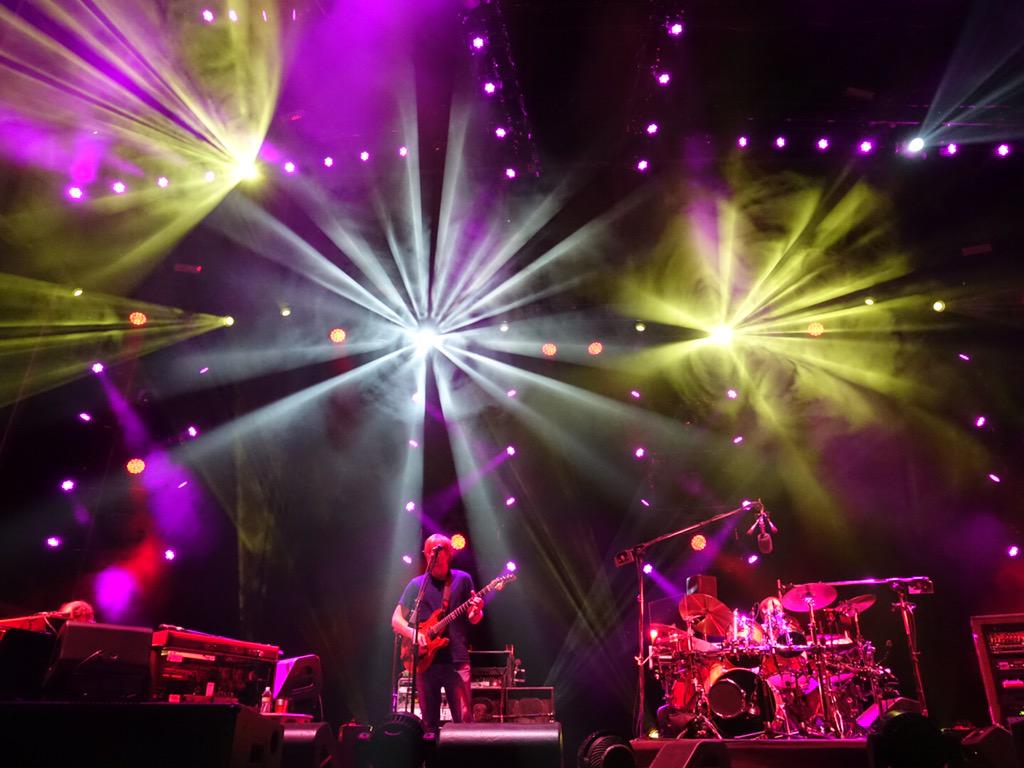
"Down With Disease" – Photo © @tweeprise
When they came back on for the encore just after midnight and launched into "Tweeprise," the plot thickened. A "Tweeprise" stand-alone encore would be rare but perhaps it made sense with the show running past curfew.
The best Phish moments always seem to be unexpected. Truth be told, even if the show had ended right here, it would have capped off an amazing weekend in every respect. But it didn't. The band recognized the significance of Dick's all along, and had completely faked us out. In 2011 we got the 'S' show. In 2012 they spelled "Fuck Your Face." In 2013 they spelled backwards. Last year gave us the "Lushington" fake out. Each year a new twist. What was left to do? All the permutations had seemingly been exhausted. All but one: spell a message on the last night.
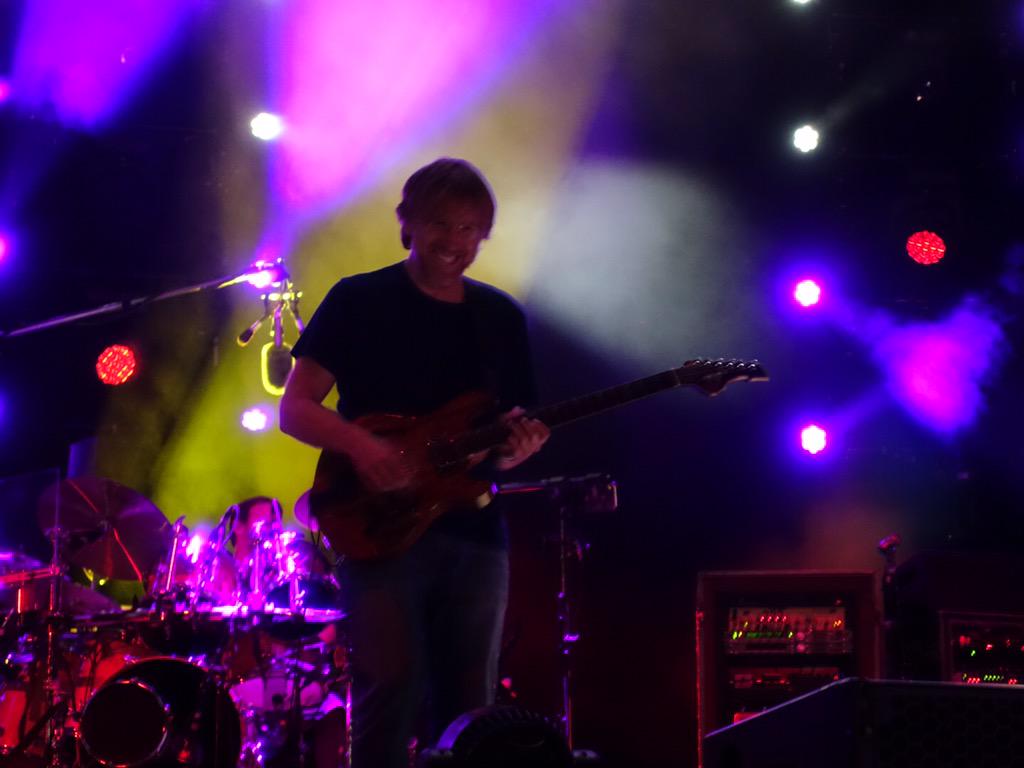
"Tweezer Reprise" – Photo © @tweeprise
"Oom pa pa oom pa pa oom pa pa oom pa paaaaaaa-ah!" Setlist antics were the farthest thing from anyone's mind when "Harpua" started up. Trey clued everyone in by letting us know that when you write your setlist to only include "Harpua" once, and to "keep that in the back of your mind." Of course, that went completely over my head. In this installment of the story, east coast Jimmy needed an oxygen tank to cope with the altitude in Colorado. On his turntable he played the appropriately timed "After Midnight." But it turns out he bought the oxygen tank at the Phish show and it was really "NO2" (played for the second time this tour). Somehow this led into the first "Keyboard Cavalry" since 1995, and the bells brought Jimmy back to consciousness whereupon he noticed "Your Pet Cat," Poster Nutbag.
Unfortunately, Mike accidentally ate Poster Nutbag, causing Jimmy to wax philosophical and ask himself "How did I get here?" Thus spawned the first "Once in a Lifetime" since the Remain in Light set in '96. Was it a little rough around the edges? Sure. Did that matter even a little? Not really. We truly were in "Once in a Lifetime" territory at this point. To finish up the message, Trey thanked us all for being a part of this unique community, wrapping up with the Brotherhood of Man song, "United We Stand."
Of course, we should really be the ones thanking Trey, Mike, Page and Fish for the amount of joy that they bring to all of our lives. The fact that they are still doing it after all these years and at such a high level is nothing short of amazing. Last night, after over 32 years of shows, Phish delivered the Best. Encore. Ever. No qualifier necessary. It will certainly go down as one of the most joyful moments I’ve ever experienced at a Phish show. The legend of Dick’s continues.
Phish Summer 2015 – Setlists & Recaps
07/21/15 Setlist – Recap – Bend 1
07/22/15 Setlist – Recap – Bend 2
07/24/15 Setlist – Recap, Recap2 – Shoreline
07/25/15 Setlist – Recap – LA Forum
07/28/15 Setlist – Recap – Austin
07/29/15 Setlist – Recap – Grand Prarie
07/31/15 Setlist – Recap – Atlanta 1
08/01/15 Setlist – Recap – Atlanta 2
08/02/15 Setlist – Recap – Tuscaloosa
08/04/15 Setlist – Recap – Nashville
08/05/15 Setlist – Recap – Kansas City
08/07/15 Setlist – Recap – Blossom
08/08/15 Setlist – Recap – Alpine 1
08/09/15 Setlist – Recap – Apline 2
08/11/15 Setlist – Recap – Mann 1
08/12/15 Setlist – Recap – Mann 2
08/14/15 Setlist – Recap – Raleigh
08/15/15 Setlist – Recap – Merriweather 1
08/16/15 Setlist – Recap – Merriweather 2
08/21/15 Setlist – Recap – Magnaball 1
08/22/15 Setlist – Recap – Magnaball 2
08/23/15 Setlist – Recap – Magnaball 3
09/04/15 Setlist – Recap – Dick's 1
09/05/15 Setlist – Recap – Dick's 2
09/06/15 Setlist – Recap – Dick's 3

Commerce City, CO posters by Rich Kelly. 12x24, Edition of 850 each night.
DICK'S 2 RECAP: TWIST AND SHOUT!
Saturday night at Dick’s started somewhat ominously – as the early crew assembled around the stage, dark clouds and stiffer breezes were of enough concern that the stage crew was forced to scramble and lower the Page-side PA stack, which was swaying precariously from the rafters. The storm clouds passed... and this minor non-event was the only real thing that went “wrong” all night. The rest was all win.
There would be an abundance of Peak Phish performed this evening, but it didn’t come early. The new summer dance machine vehicle “No Men In No Man's Land” opened a show for the second time this summer. Showing such early promise upon which fans have rightly heaped considerable praise, this version didn’t sniff the peaks of the Forum, Mann, or MagnaBall versions from earlier in the tour, but set an upbeat tone that carried into a compact but excellent “Martian Monster.” The set then settled in to stock footage with a mostly forgettable sequence of “NICU,” “Stealing Time From the Faulty Plan,” “Bouncing Around the Room” and “555.”

Photo by Patrick Jordan © Phish From the Road
At this point we we’re looking at the inflection point of the set – it wasn’t honestly going very well, with a real sense of going through the motions. In the song’s early days, most fans would certainly not have thought of “Winterqueen” as a song that could step in to save a set, but that’s pretty much what happened, as if there was a mid-set recalibration. While Fuego’s title track initially seemed most likely to provide the best opportunity for improvisational expansion (and has indeed offered many gems), “Winterqueen” has quietly become perhaps the most consistent contributor from that song batch. A comparatively rare mid-set “Split Open and Melt” opened the jamming jets with some dark tension established with Trey and Page engaged in delightfully weird swirling counterpoints. An excellent “Limb By Limb” and soaring “Roggae” offered a perfect pairing of contemplation and soul-inspiring peaks, before “Character Zero” (“the crowd was going wild”) took us into the break. The set had some balance issues, but it grew progressively better as it went along, and left high hopes for the money frame.
The second-set opening “A Song I Heard the Ocean Sing” didn’t go deep but was more than a table-setter, burning brightly as the first stage rocket booster was released, igniting the show’s improvisational centerpiece, “Chalk Dust Torture.” Up against stiff competition for the title of Dick’s Finest Dust (see 8/31/12 and 8/31/13), this year’s “CDT” was a thrilling ride, an active and exploratory adventure of sound, shape, light, and vibration that was so deep and rich and brimming with joy that you never wanted it to end. Rounding out at a little over sixteen minutes it seemed considerably longer. As exhilarating as the “CDT” proper was, the dream textbook segue into “Twist” was a beauty to behold. The best of song transitions happen organically, where the seeds of the subsequent song are infused with ease, grace, patience, and dramatic pregnant intention. Trey laid the first hints of the "Twist" well over a minute before they dropped into the song proper, with everyone else insistent on powering through on the current jam theme. Trey guided them to a blissful and brilliantly fluid culmination into “Twist,” leaving a Peak Phish moment that is in a class with some of the greatest segues in Phish’s history.

Photo by Patrick Jordan © Phish From the Road
The “Twist” proper was gravy and yielded to the third-ever performance of “Mercury,” its first in a big second set slot. The song having several sections led to a funny exchange with a buddy: he asked “what song is this?” “Mercury.” Then a few minutes later, “so what song is this?” “Mercury.” “No, this one?” “Still ‘Mercury’!” They’ve been working this song out in soundcheck over the course of the tour which paid considerable dividends tonight. More or less out of the blue – and after two consecutive years of adding sizeable batches of new songs in each of the last two Halloweens – ”Mercury” is a pretty huge development, given it is one of if not the most significant new original of the post-breakup era. Fish’s Marimba Lumina solo bridges the song’s two main sections, and the timing of this section in the flow of the set contained the slightest echo of “Drums” > “Space.” “Mercury” is a hybrid club in Phish’s bag, with engaging composition yet offering tremendous freedom to roam and explore. Get comfortable with “Mercury” – this winner is here to stay.
The set could easily have coasted home to victory on a succession of set-closers at this point, but the improvisational fuel was still burning bright enough for a late-set “Light” that packed enough ideas for a jam twice its length, with Page and Fish contributing especially vibrant and engaging performances. A powerful, dramatic and perfectly-placed “Wingsuit” soared its way to a emphatic, ground-shaking, fist-pumping “Rock and Roll” to take the set home.

"Split Open & Melt" – Photo © @tweeprise
Page seemed legitimately choked-up leading in to his favorite encore song, “Sleeping Monkey,” before we headed into true bonus time with a bright, happy, cathartic “Harry Hood.” “A Day in the Life” finally closed the books on this show that saw the band using all the weapons in its considerable arsenal of artistic magic that we’ve all been so privileged to witness. I’d be remiss not to note how exceptional the crowd has been; in contrast to a few of the nights last year, front center floor has been virtually stress-free with considerable space and minimal-to-non-existent hassle. One last night to empty the tank before we head into the fall break. Be in the moment, but consider taking a few of those moments for inventory, to reflect upon the bounty of awesome which we can be thankful for: our friends, our band, our community. It’s a happy time in the Phish world, so soak it in!
Phish Summer 2015 – Setlists & Recaps
07/21/15 Setlist – Recap – Bend 1
07/22/15 Setlist – Recap – Bend 2
07/24/15 Setlist – Recap, Recap2 – Shoreline
07/25/15 Setlist – Recap – LA Forum
07/28/15 Setlist – Recap – Austin
07/29/15 Setlist – Recap – Grand Prarie
07/31/15 Setlist – Recap – Atlanta 1
08/01/15 Setlist – Recap – Atlanta 2
08/02/15 Setlist – Recap – Tuscaloosa
08/04/15 Setlist – Recap – Nashville
08/05/15 Setlist – Recap – Kansas City
08/07/15 Setlist – Recap – Blossom
08/08/15 Setlist – Recap – Alpine 1
08/09/15 Setlist – Recap – Apline 2
08/11/15 Setlist – Recap – Mann 1
08/12/15 Setlist – Recap – Mann 2
08/14/15 Setlist – Recap – Raleigh
08/15/15 Setlist – Recap – Merriweather 1
08/16/15 Setlist – Recap – Merriweather 2
08/21/15 Setlist – Recap – Magnaball 1
08/22/15 Setlist – Recap – Magnaball 2
08/23/15 Setlist – Recap – Magnaball 3
09/04/15 Setlist – Recap – Dick's 1
09/05/15 Setlist – Recap – Dick's 2
09/06/15 Setlist – Recap – Dick's 3

Commerce City, CO posters by Rich Kelly. 12x24, Edition of 850 each night.
DICK'S 1: CAN I BUY A VOWEL?
Night one of Dick’s. Home to some of the most storied shows of Phish 3.0, with all sorts of setlist shenanigans. The “S” show. “Fuck Your Face.” “Most Shows Spell Something.” The “Lushington” fakeout. What would tonight bring?
A short but sweet “Tube” opened the show, but the fun thing about first night Dick’s is that even when songs stay within the song’s usual confines, the mind starts racing in crossword puzzle mode: “What could they be spelling?” During Page’s initial clavinet solo, Trey and Mike turned to each other and stood close (as they have several times this summer, notably during the Magnaball “Twist"), holding down the rhythm. “Ghost” followed, sending fans scrambling for their Scrabble dictionaries and coming up empty, “tg” not being found at the beginning nor “gt” at the end of many words. Trey's solo during “Ghost" was delicate and patient, and – simply because it wouldn’t be a summer 2015 recap without this statement – seemingly influenced by his time preparing for and playing at the Fare Thee Well shows.

Photo by Patrick Jordan © Phish From the Road
A deep dark slowdown finish to “Ghost” lead into the upbeat opening of “Halley’s Comet.” An allegro tempo and some fun duel-style interplay between Trey and Page started the “Halley’s" jam, which seemed to be going somewhere fast, but screeched to a halt when Trey played the opening riff to “Undermind.” A fun “Undermind,” but – unless they were spelling in Dothraki – it seemed unlikely that either “TGHU” or “UHGT” were at the beginning or end of any words. “Yarmouth Road” followed, and with a fun but relatively straightforward first set underway, “Bathtub Gin” brought hopes of a tentpole jam. One thing that has stood out about 2015 has been the ability of the band to instantly drop into a raging up-tempo jam, with very little noodling to find their way there. This “Gin” is a perfect example of this phenomenon – a very short build to a great raging peak.
After a short onstage discussion, the band decided on “Waiting All Night.” “Waiting” is a departure for Phish – one of several on Fuego that works better in the studio than live. “Horn” set up "The Wedge,” which was stretched out a bit, with a fairly exciting jam tacked on. “46 Days” had the feel of a set closer as soon as it started, got to a point where I thought they were raving up to end the set, and then took an amazing Trey-led turn into type-II territory. Bathed in intense black lights by Kuroda, Page drove the jam with some fantastic work on the organ as the band veered into a spacey place halfway between a "Harry Hood" jam and Pink Floyd’s “Dogs,” before segueing into “Run Like an Antelope.” Page stayed on the Hammond through the opening section of “Antelope,” which gave it an unusual Jimmy Smith feel. This “Antelope” jam was slow to build, with Page back on piano trading licks with Trey, but reached a typically wild set-closing peak with lights from Kuroda to match. During the final “Antelope” rave-up, Trey happily announced “We love Dick’s! We’re happy to be back!"

Photo © @stim_buck
On the webcast, a slideshow of summer tour photos was shown during setbreak, accompanied by music from Neu!’s self-titled debut album. Reflecting on the first set, it was (as they say) first setty, but there were highlights in the brief “Halley’s" jam, the "Bathtub Gin" and the "46 Days" -> “Antelope.” With the first letters from the first set songs spelling TGHUYBWHWFR, it seemed as if the word play from Dick’s in years past was left behind.
“Wolfman’s Brother” came down on me to open the second set. While most 3.0 “Wolfman’s” have been good-to-great – often as a centerpiece jam of a first set – the truly extended jamming the song would sometimes see in 1.0 and 2.0 has been absent. I had high hopes that the prime jamming slot placement of this “Wolfman’s” would lead to such an excursion. This jam didn’t disappoint, even if it stayed within the ten-to-twelve minute confines of most 3.0 versions – Mike held down an incredibly strong bass line throughout that Trey used as a launching pad for some inspired improvisation. A very chill end to the jam with some great keyboard work by Page faded into the bouncy opening of “Blaze On.”
I was pretty down on “Blaze On” following its debut, mostly due to the stoner-pandering lyrics. But the great jams at Shoreline and especially Magnaball, along with the truly infectious happiness with which Trey sings the song has made me a believer. The Dick's “Blaze On” can proudly stand with those versions and cements its place as a great jam vehicle. A spacey Floyd-esque part of the jam instead ended up being a Trey-led transition into "Golden Age.” The composed section, however, was a bit tarnished, with some pretty harsh flubs. It’s fair to say that even in the beginning of the jam, Trey still did not seem to be feeling it. However, this allowed Page to take the lead, which he did with aplomb, leaning heavily on his electric piano. Trey was seemingly content to remain in a rhythm role for the middle portion of the jam, with mike using his meatball pedal to great acclaim from the crowd. Trey eventually regained his footing, and with some great drum fills and changes from Fishman, jumped back into the lead role, playing some anthemic riffs with some judicious use of his whammy pedal. A fantastic version.

Photo by Patrick Jordan © Phish From the Road
Having redeemed “Golden Age” from a rough composed section, the band started another fan favorite cover, “Roses Are Free.” Unfortunately, it also featured a problematic composed section, with no jam to speak of, just a dissonant rave-up that gave way to “Fuego.” Being a song they wrote, they found solid footing in the composed section, which allowed a climb into one of the more interesting “Fuego” jams, with some dark riffing by Trey that built to a climax. This lead to a tender refractory period, featuring Fishman doing some delicate work on the drums, Trey using delay pedals and a Page-led sideways slide into well-executed “Wading in the Velvet Sea.” Continuing the theme of songs starting with a Page piano riff, “Walls of the Cave” was up next, reprising the same set closing sequence from the second day of Magnaball. “Walls” was a rocking set closer, and I’m happy to see this tune enter heavier rotation as opposed to a typical "Character Zero” to end the set.
The smart money was on a standard “Loving Cup” or “Julius” encore, but instead the band returned to play “Hold Your Head Up” while Fishman and Trey – wearing a "LET FISH SUCK" T-shirt – switched places on stage. Fish, following a bit of banter about Syd Barrett, started to sing an inspired version of “Bike.” This was an outstanding version with a truly great and melodic vacuum solo. Another refrain of “HYHU” allowed Fishman to swing his vacuum hose, jump on the piano, bow excitedly, sprint around the stage and generally act like a madman. Trey and Fishman then made their way back to their own instruments, and proving that the smart money is always right, played a rollicking version of “Loving Cup” to close the show.
The absence of setlist wordplay antics may have led to a more standard song selection than previous Friday night Dick’s shows, but there was a lot to like here. Highlights of the second set were the “Wolfman’s” through “Golden Age” sequence, and “Bike," with an honorable mention to what was a very good “Fuego.” The jams were great examples of 2015 Phish, where the band can seemingly find a happy place quickly, with minimal navigation required. While not quite reaching the peaks of Magnaball, the band shrugged off the 11-night layoff. It’s getting to the point where Phish at Dick’s is one of the surest things in rock and roll music, and this portends great things for Saturday and Sunday night.
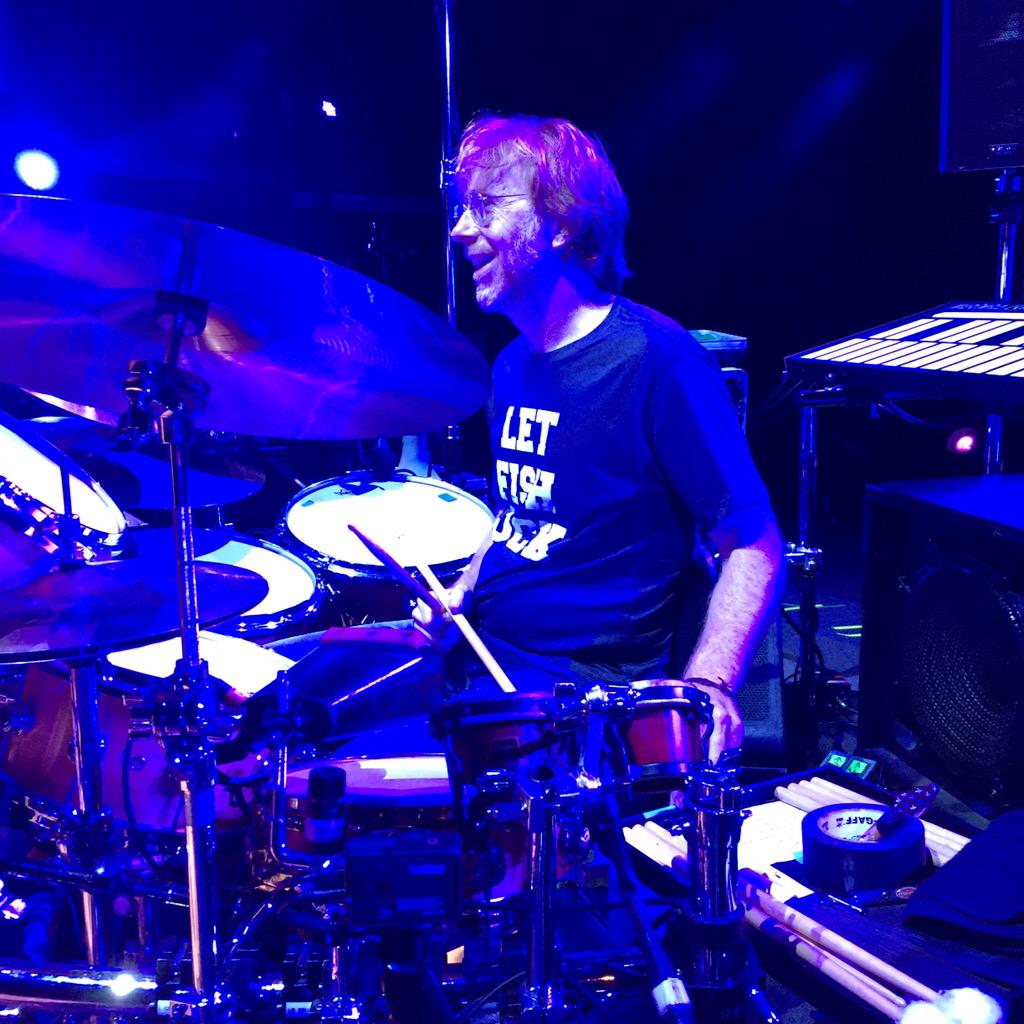
Photo © Mike Gordon
Phish Summer 2015 – Setlists & Recaps
07/21/15 Setlist – Recap – Bend 1
07/22/15 Setlist – Recap – Bend 2
07/24/15 Setlist – Recap, Recap2 – Shoreline
07/25/15 Setlist – Recap – LA Forum
07/28/15 Setlist – Recap – Austin
07/29/15 Setlist – Recap – Grand Prarie
07/31/15 Setlist – Recap – Atlanta 1
08/01/15 Setlist – Recap – Atlanta 2
08/02/15 Setlist – Recap – Tuscaloosa
08/04/15 Setlist – Recap – Nashville
08/05/15 Setlist – Recap – Kansas City
08/07/15 Setlist – Recap – Blossom
08/08/15 Setlist – Recap – Alpine 1
08/09/15 Setlist – Recap – Apline 2
08/11/15 Setlist – Recap – Mann 1
08/12/15 Setlist – Recap – Mann 2
08/14/15 Setlist – Recap – Raleigh
08/15/15 Setlist – Recap – Merriweather 1
08/16/15 Setlist – Recap – Merriweather 2
08/21/15 Setlist – Recap – Magnaball 1
08/22/15 Setlist – Recap – Magnaball 2
08/23/15 Setlist – Recap – Magnaball 3
09/04/15 Setlist – Recap – Dick's 1
09/05/15 Setlist – Recap – Dick's 2
09/06/15 Setlist – Recap – Dick's 3

Commerce City, CO posters by Rich Kelly. 12x24, Edition of 850 each night.
RIVIERA MAYA SHOWS ANNOUNCED

Phish has announced a three concert run in Mexico's Riviera Maya at the The Barceló Maya resort on January 15-17, 2016. This unique series of three shows on the beach will be sold as part of an all-inclusive resort vacation, with food, drinks, concert tickets and lodging included in the price. Airfare is not included, but transportation to and from the resorts is. A choice of four resorts is available; no concert tickets will be sold outside of the all-inclusive resort packages. There are three and four night packages available, with a variety of rates (ranging from $1349 pp -$3149 pp) depending on occupancy, room size, length of stay and resort. Reduced rates for children are available.

Tickets go on sale September 10th at 11AM EDT and can be purchased only via the web here: http://cidphishrivieramaya.shop.ticketstoday.com.
THEY'RE AN AMERICAN BAND
Today's guest blogger is Professor Paul Jakus, of the Department of Applied Economics at Utah State University. We are honored to share his writing and research, and welcome other academics to contribute scholarly analysis of the band's history, as well.
Before the 2015 tour kicked off, @Lemuria analyzed where Phish has played over the years using Census divisions. He argued that not only does the west coast not get screwed; it gets more than its fair share of shows, while New England — the band’s home turf — is the region that gets shafted.
But analysis by Census divisions didn’t seem right to me. Census Divisions in the east are much smaller than those in the west, potentially distorting the analysis. Instead, why not calculate the geography of Phish shows the same way the Census Bureau determines the geographic center of the population?
What is a geographic population center? Think of a map of the U.S. as a table to be balanced on a single leg. Each person is a weight placed on the table where they live: In 1790, more Americans lived on or near the Atlantic coast; so, the leg on which the table is to be balanced must be placed very far to the east. (In 1790, this was in Kent County, MD.) To maintain the balance as Americans migrated west, the leg was moved further and further to the west. This Census Bureau map shows the westward movement of Americans with every Census since 1790:
We can do the same thing with Phish shows, using the latitude, longitude, and the number of shows played in any town. Restricting the analysis to North America, Phish has played at 322 known locations since 1987. I calculated the mean geographic center of Phish shows, by year, using the Census Bureau formulae with the number of shows (instead of population) as the weight. Holiday runs breaking over more than one calendar year were assigned to a single year.
In 1987, the geographic center was located just south of Burlington, VT. The well-known Telluride shows of 1988 pulled the geographic center further west (to near Canandaigua, NY), but then it reverted back to Stratton, VT, in 1989, as Phish spent that year closer to home. The band’s growth as a touring act can be seen when the geographic center rocketed over 600 miles to the west in 1990 (to near Utica, OH). The geographic center has since stayed firmly rooted in the heartland of Ohio, Indiana, and Illinois for most years. Prior to 2014, 1996 was the only year that the center moved west of the Mississippi River. But Lemuria’s central argument is correct: In 2014 and 2015, Phish played, on average, further west than it ever had.
What about that green dot near the 2014 and 2015 geographic centers? That turns out to be the 2010 geographic center of the U.S. population (Texas County, MO). Like it or not, Phish’s recent touring years have been almost perfectly balanced with the U.S. population. They’re an American band.


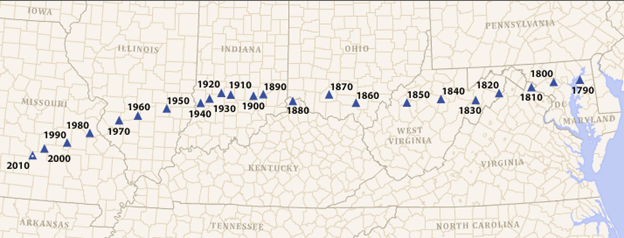
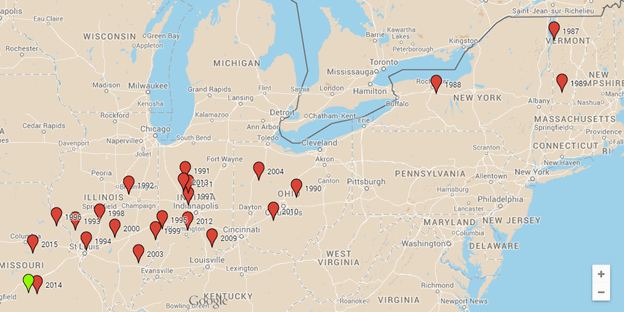
 The Mockingbird Foundation
The Mockingbird Foundation